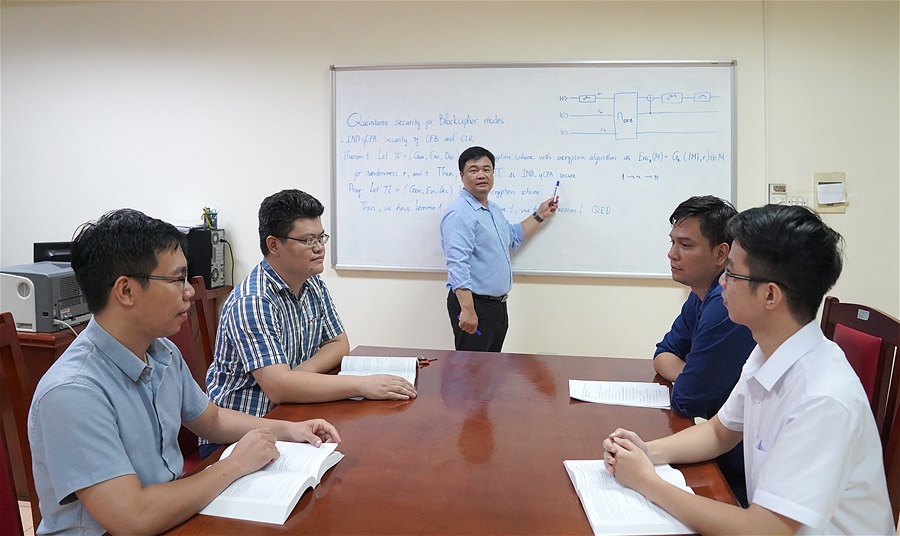How secure is the Advanced Encryption Standard with random ShiftRows against Fault Analysis
Tóm tắt - Với việc thuật toán mã hóa Rijndael được chấp nhận là Tiêu chuẩn mã hóa nâng cao (Advanced Encryption Standard - AES), và một loạt các công trình nghiên cứu về một hoặc một số chức năng bên trong của thuật toán phụ thuộc vào khóa đã được công bố. Bài báo này trình bày về nghiên cứu mô hình phân tích lỗi dựa trên thuật toán AES và phân tích các thuật toán mã hóa động (theo nghĩa phụ thuộc khóa) dựa trên AES. Trong đó, các hàm nội bộ ShiftRows được chọn ngẫu nhiên trong mỗi vòng, để đánh giá mức độ nguy hiểm của cuộc tấn công.
|
REFERENCES [1]. A. Al-Wattar and et al. “A New DNA Based Approach of Generating Key-Dependent Shift Rows Transformation”. International Journal of Network Security and Its Applications, 7(1), 2015. [2]. A. Alfonso. “Generaci´on Aleatoria de Permutaciones con Optima Di-´ fusio´n”. Memorias del III Seminario Cient´ıfico Nacional de Criptograf´ıa, Instituto de Criptograf´ıa de la Universidad de la Habana, La Habana, Cuba, 2016. [3]. A. Alfonso and P. Freyre, “AES Modificado con ShiftRows Aleatorio”. Memorias del XV Congreso Internacional de Matem´atica y Computaci´on, Sociedad Cubana de Matem´atica y Computaci´on, La Habana, Cuba, 2017. [4]. S. Ali, D. Mukhopadhyay, and M. Tunstall. “Differential Fault Analysis of AES: Towards Reaching its Limits”. Journal of Cryptographic Engineering, 3(2):pp. 73–97, 2012. [5]. E. Barkan and E. Biham. “In How Many Ways Can You Write Rijndael”. LNCS 2501, pp. 160–175, 2002. [6]. E. Biham and A. Shamir. “Differential Fault Analysis of Secret Key Cryptosystems”. LNCS 1294, pp. 513–525, 1997. [7]. J. Blomer and J. Seifert. “Fault Based Cryptanalysis of the Advanced Encryption Standard (AES)”. IACR Cryptology ePrint Archive, 075, 2002. [8]. J. Daemen and V. Rijmen. “The Design of Rijndael: AES - The Advanced Encryption Standard”. Springer-Verlag, 2002. [9]. C. Dobraunig and et al. “Exploiting Ineffective Fault Inductions on Symmetric Cryptography”. IACR Cryptology ePrint Archive., 071, 2018. [10]. C. Dobraunig and et al. “Statistical Ineffective Fault Attacks on Masked AES with Fault Countermeasures”. IACR Cryptology ePrint Archive., 357, 2018. [11]. P. Dusart, G. Letourneox, and O. Vivolo. “Differential Fault Analysis on AES”. IACR Cryptology ePrint Archive, 010, 2003. [12]. “European Union Agency for Network and Information Security”. Algorithms, Key Size and Parameters Report. 2014. [13]. “Federal Information Processing Standard. Announcing the Advanced Encryption Standard (AES)”. FIPS Publication 197, 2001. [14]. A. Ghoshal, S. Patranabis, and D. Mukhopadhyay. “Template-based Fault Injection Analysis of Block Ciphers”. IACR Cryptology ePrint Archive., 072, 2018. [15]. G. Giraud. “DFA on AES”. LNCS 3373, pp. 27–41, 2005. [16]. N. Hussein and et al. “A Byte-Oriented Multi Keys ShiftRows Encryption and Decryption Cipher Processes in Modified AES”. International Journal of Scientific and Engineering Research, 5, 2014. [17]. I. Ismail and et al. “Performance Examination of AES Encryption Algorithm with Constant and Dynamic Rotation”. International Journal of Reviews in Computing, 12, 2012. [18]. M. Joye and M. Tunstall. “Fault Analysis in Cryptography”. SpringerVerlag, 2012. [19]. L. Knudsen and M. Robshaw. “The Block Cipher Companion”. SpringerVerlag Berlin Heidelberg, 2011. [20]. D. Mukhopadhyay. “An Improved Fault Based Attack of the Advanced Encryption Standard”. LNCS 5580, pp. 421–434, 2009. [21]. P. Nidhinraj and J. George. “DNA-based Approach of AES with Key Dependent ShiftRows”. International Journal of Control Theory and Applications, 9(43), 2016. [22]. G. Piret and J. Quisquater. “A Differential Fault Attack Technique against SPN Structures, with Application to the AES and KHAZAD”. LNCS 2779, pp. 77–88, 2003. [23]. D. Saha, D. Mukhopadhyay, and D. RoyChowdhury. “A Diagonal Fault Attack on the Advanced Encryption Standard”. IACR Cryptology ePrint Archive, 581, 2009. [24]. B. Schneier. Applied Cryptography: “Protocols, Algorithms, and Source Code in C”. John Wiley & Sons, 1996. [25]. M. Spain and M. Varia. “Diversity Within the Rijndael Design Principles for Resistance to Differential Power Analysis”. LNCS 10052, pp. 71–87, 2017. |
Thông tin trích dẫn bài báo: Adrián Alfonso Peñate, Pablo Freyre Arrozarena, "How secure is the Advanced Encryption Standard with random ShiftRows against Fault Analysis", Nghiên cứu khoa học và công nghệ trong lĩnh vực An toàn thông tin, Tạp chí An toàn thông tin, Vol. 07, pp.14-21, No.01, 2018.
Adrián Alfonso Peñate, Pablo Freyre Arrozarena



















